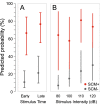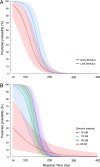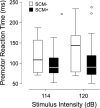Response triggering by an acoustic stimulus increases with stimulus intensity and is best predicted by startle reflex activation
- PMID: 34880317
- PMCID: PMC8655082
- DOI: 10.1038/s41598-021-02825-8
Response triggering by an acoustic stimulus increases with stimulus intensity and is best predicted by startle reflex activation
Abstract
In a simple reaction time task, the presentation of a startling acoustic stimulus has been shown to trigger the prepared response at short latency, known as the StartReact effect. However, it is unclear under what conditions it can be assumed that the loud stimulus results in response triggering. The purpose of the present study was to examine how auditory stimulus intensity and preparation level affect the probability of involuntary response triggering and the incidence of activation in the startle reflex indicator of sternocleidomastoid (SCM). In two reaction time experiments, participants were presented with an irrelevant auditory stimulus of varying intensities at various time points prior to the visual go-signal. Responses were independently categorized as responding to either the auditory or visual stimulus and those with or without SCM activation (i.e., SCM+/-). Both the incidence of response triggering and proportion of SCM+ trials increased with stimulus intensity and presentation closer to the go-signal. Data also showed that participants reacted to the auditory stimulus at a much higher rate on trials where the auditory stimulus elicited SCM activity versus those that did not, and a logistic regression analysis confirmed that SCM activation is a reliable predictor of response triggering for all conditions.
© 2021. The Author(s).
Conflict of interest statement
The authors declare no competing interests.
Figures












References
Publication types
MeSH terms
LinkOut - more resources
Full Text Sources

